Scientific Kites of the Industrial Revolution
By M. Robinson

Meteorological
Kites
Scientific Kites of the Industrial Revolution
By M. Robinson

Meteorological kites may not have had the flash and glamour of the other Industrial Revolution kites, but they were a good, loyal, and dependable worker. They first reported for work in 1749, and did so consistently and competently until 1933, and are occasionally getting called back into active duty to this day.
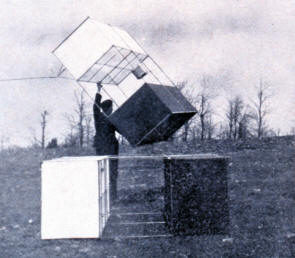 Other kite research of this era: the
pre-motorized manned flights by Hargrave, Wrights, Cody, Bell and the many
others; the many military kites, and Marconi’s and Franklin’s atmospheric kite
experiments; had better public relations. They had more interesting and
polarizing roles in history than the under-estimated and under-valued weather
kites.
Other kite research of this era: the
pre-motorized manned flights by Hargrave, Wrights, Cody, Bell and the many
others; the many military kites, and Marconi’s and Franklin’s atmospheric kite
experiments; had better public relations. They had more interesting and
polarizing roles in history than the under-estimated and under-valued weather
kites.
The first recorded weather experiments with kites were in Scotland in 1749 by two University of Glasgow students. Wondering if the air above the ground was colder or warmer than the air on the ground, Alexander Wilson and Thomas Melville put kites on a career path that would last for two centuries. The Scottish scientist required a controllable flying machine for their experiments, and since it was 30 years before the first balloon flight, and 150 years before the aeroplane, a kite flew to the rescue.
Wilson & Melville made six paper kites and tied a small thermometer to each kite. Each thermometer was bundled in strips of cloth to prevent the delicate instruments from breaking when they hit the ground. Each bundle had a slow burning fuse and a white ribbon attached. As the fuse burned through the string that bound the bundle to the kite, the white ribbons would surf the wind on a downward descent and signal to the experimenters. This was the first recorded attempt at obtaining scientific data using kites as well as the first recorded use of kites in a train.
The experiments of Wilson and Melville were successful. They published their research. However, their work went overlooked for over seventy years until Professor Wilson’s memoirs were published in England in 1825 and reprinted two years later in America. The prominent meteorologist, James Espy, read Wilson and Melville’s work in the USA while doing his own weather experiments with kites.
At about the same time (1822-1823), during Captain Sir William Edward Parry and Reverend George Fisher’s second voyage, they took weather readings from a kite while in Igloolik, an island off the northeast coast of North America. The ground temperature at the time was minus 24 F.
In 1835, the Franklin Kite Club was formed. It consisted of several gentlemen who met once a week for the purpose of flying their kites for scientific experiments. Espy, author of The Philosophy of Storms, was a member of the Franklin kite club. Sir Francis Reynolds and W. R. Birt of the Kew Gardens Observatory in England developed a six-sided meteorological kite in 1847 that allowed meteorologist to raise and lower weather instruments using a pulley system.
The works of Espy, the Franklin Club, and other meteorologist, excited scientist around the world for about ten years. Unfortunately, the invention and use of the weather balloon overshadowed any kite research for nearly the next forty years.
Then, just as quickly as the kite fell out of favor, it regained its perfect solution status. It was determined that the weather balloons had several shortcomings: a free floating balloon might be carried by high altitude winds to useless locations where the instruments could not be recovered, a tethered balloon could not be adequately controlled; lateral winds could whip it around in a large arc, or bring it down instead of up. Kites were much less expensive. Kites provided better exposure of the instruments.
British Meteorologist, E. D. Archibald introduced the use of high-tensile piano wire lines to replace kite string in 1887. The piano wire had twice the strength, one-fourth the weight, and one half the cost, of the previously used flax kite string. Wire lines had been used before, but Archibald used steel when he attached an anemometer (a wind meter) to his kites to measure the wind’s velocity 1200 feet above the earth. Archibald was also credited with being the first to hang a camera from a kite.
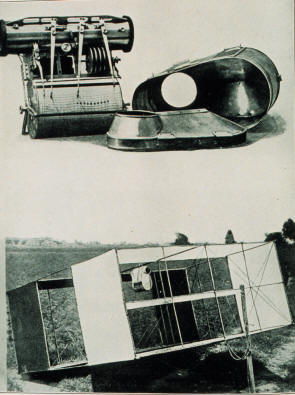 It was becoming increasingly evident
that the most kites of the time; those developed by the British meteorologists,
or the hexagonal variation kite design (1892) by America’s Alexander McAdie,
were relatively un-stable and not able to meet the increasing needs of weather
forecasting. Two closely timed developments; the bowed Eddy kite (1894) and the
Hargrave cellular kite (1893), soon made kites practical and common for
scientific experiments. From then on, until the middle of the twentieth century,
kite flying for meteorological purposes was pursued with vim, vigor, and a
single-minded dedication.
It was becoming increasingly evident
that the most kites of the time; those developed by the British meteorologists,
or the hexagonal variation kite design (1892) by America’s Alexander McAdie,
were relatively un-stable and not able to meet the increasing needs of weather
forecasting. Two closely timed developments; the bowed Eddy kite (1894) and the
Hargrave cellular kite (1893), soon made kites practical and common for
scientific experiments. From then on, until the middle of the twentieth century,
kite flying for meteorological purposes was pursued with vim, vigor, and a
single-minded dedication.
William Eddy began by using trains of “ordinary” hexagonal kites to lift thermometers in 1890. However, he was soon frustrated with their limitations. As the story goes: Eddy had heard of a bowed kite used for hundreds of years by natives of the South Pacific. He experimented with various configurations, trying to build one, even though he had never yet seen one. He hit upon two big breaks in 1893. Eddy saw a native Javanese kite at the 1893 World’s Fair in Chicago. He also received correspondence from a man in South Africa who described bowed kites that he had obtained from a merchant returning from Indonesia. Armed with this new information, William Eddy took a Malay kite, modified it to equal dimensions, and bowed the cross stick. With better kite designs and simple, light, and efficient self-recording instruments developed in France, meteorological kite research flourished.
During August of 1894, William Eddy brought his kites to the Blue Hill Observatory in Boston to demonstrate their effectiveness. A. Lawrence Rotch privately ran the Blue Hill Observatory near Harvard. On August 4th, Eddy made the earliest automatic record of air temperature using kites. On that day, five bowed Eddy kites, with a total area of nine square meters, lifted a two and a half pound instrument to a height of 1,400 feet. During the next year, trains of Eddy kites were used at Blue Hill for raising instruments.
However, it became apparent that the ‘workhorse’ Hargrave box kite was even more perfectly suited was for the study of weather. So obvious was it, in fact, that William Eddy himself wrote to Lawrence Hargrave, in December of 1893, asking for permission to use the box kite in his weather experiments. The box kite was implemented by both Blue Hill and the U.S Weather Bureau in 1895 and would continue to be employed for meteorological work for over thirty years.
As of 1899, the Weather Bureau’s kiting system, which consisted of box kites attached to a main line at two thousand foot intervals, developed to a point where the measuring equipment was consistently lifted to altitudes exceeding 10,000 feet. The land power to control the powerful kite system had been available since 1896 by means of a sturdy steam-driven windlass, a modification of an apparatus developed by Sir William Thompson for deep-sea sounding. The windlass’ reel could hold up to 40,000 feet of 14-gauge (0.03 inch) wire, which was spliced together at 8,000-foot intervals. A dynamometer was attached to the winch-driven reel to measure the pull on the kite line. The pull in pounds told the men operating the kite station when to add secondary kites as well as when to begin reeling in kites.
The zeal in which kites were used in meteorological research was ignited by the vision and passion of two top officials at the U.S Weather Service of that time: Charles F. Marvin, who directed the opening of seventeen kite stations around the country to be used for regular weather observation, and Willis L. Moore, who promoted the use of kite trains in the early 1890’s. Both of these men championed the use of kites to be used for exploring the atmosphere. Marvin also designed the meteorograph; the basic instrument carried on kites used for the testing of temperature, wind velocity, humidity at increasing altitudes, and barometric pressure.
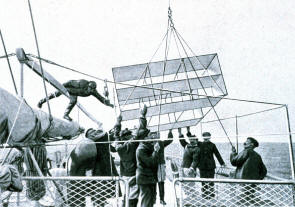 During Marvin’s twenty-one years as
Chief of the U.S. Weather Bureau, the use of kites for weather observation was
perfected to an exact science. Each and every detail pertaining to the kite
design, materials used, launching and landing, sites for launching, and
countless other aspects of the operation were spelled out in the reams of
government specifications. Nothing was left to chance. For example, the launch
site was specified as a 40-acre square tract of land with open country to the
east but with a small town approximately one kilometer to the west. The site had
to be level, cleared of trees and stumps, and surrounded by a strong fence to
keep out livestock. In addition, the surrounding country needed to be free of
forested tracts, lakes, marshes, rivers, streams and electric railways, as well
as high-tension power lines.
During Marvin’s twenty-one years as
Chief of the U.S. Weather Bureau, the use of kites for weather observation was
perfected to an exact science. Each and every detail pertaining to the kite
design, materials used, launching and landing, sites for launching, and
countless other aspects of the operation were spelled out in the reams of
government specifications. Nothing was left to chance. For example, the launch
site was specified as a 40-acre square tract of land with open country to the
east but with a small town approximately one kilometer to the west. The site had
to be level, cleared of trees and stumps, and surrounded by a strong fence to
keep out livestock. In addition, the surrounding country needed to be free of
forested tracts, lakes, marshes, rivers, streams and electric railways, as well
as high-tension power lines.
The government weather observers used three different sized kites. They were classified as high-wind kites, moderate-wind kite for 12 to 30 miles per hour winds, and light-wind kites for 8 to 10 mph winds. The moderate wind kite used by the U.S. Weather Bureau up until 1933 was made as follows: length 6 feet 8.5 inches (204 cm), width 6 feet 5.5 inches (197 cm), Depth of cell 2 feet 8.5 inches (83 cm), lifting surface was 68 square feet (6.3 sq. meters), weight is 8.5 pounds (3.8 kilograms), the framework consisted of 41 pieces of straight-grained spruce, weather bureau carpenters used 78 metal angles to fasten joints, coarse waxed lined thread and 175 feet of fine piano wire were used for supplementing the reinforcing of metal angles and for bracing, the fabric surface was 13 yards of 26.5 inch wide Lonsdale cambric cloth, although sometimes the rear cell and occasionally both front and rear cells were made of silk which was less likely to become water logged in rain. The one change that Marvin made to the Hargrave box kite was that, while the outside dimensions of both the front and rear cells remained the same, the front cell was subdivided so that it consisted of two cells, providing a stronger structure to carry instruments. A common problem for the Weather Bureau kite fliers was when the surface fabric absorbed moisture and dried it shrank, the contraction of the surface fibers during shrinkage was powerful enough to distort and even crush parts of the wooden frame.
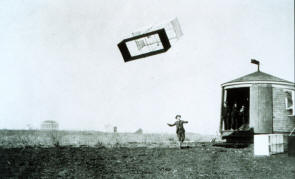 As far as I am concerned, the
greatest development to come out of two hundred years of weather research
involving kites was the kite reel house! It was, bar none, the
most ingenious contribution to kiting. A kite reel house looks like a round
garage that is mounted on a turntable so that it can turn to face any direction
desired according to the prevailing wind.
As far as I am concerned, the
greatest development to come out of two hundred years of weather research
involving kites was the kite reel house! It was, bar none, the
most ingenious contribution to kiting. A kite reel house looks like a round
garage that is mounted on a turntable so that it can turn to face any direction
desired according to the prevailing wind.
As the U.S Weather Bureau matured, they turned their attention from altitude records and static electricity experiments to obtaining regular accurate reports. That meant almost daily flights in every kind of weather imaginable. During the winter months the kite line (cold hard piano wire) had to be wiped free of ice and frost before it could be reeled in. The piano wire kite line also had to be oiled regularly to avoid rusting. Constant maintenance like this certainly would have taken the romantic notion of kite flying out of ones head rather quickly.
The dawn of the twentieth century saw many European and American meteorological bureaus using kites in their research regularly. In England in 1902, W. H. Dines collaborated with W. N. Shaw in a series of private kite experiments for which they received some financial support from the government. The first British kite station was set up in Crinan, off the west coast of Scotland. Deciding it would make them less dependent on the strength of the wind, Dines and Shaw used a steam-tug boat to take readings at sea. Later, a naval vessel was put at their disposal. They also took readings at Oxshott and Pyrton Hill.
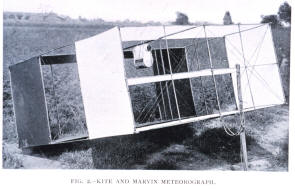 In America, the kite of choice to be
used by the U.S Weather Service and privately run research stations such as Blue
Hill, was the Hargrave box kite. In Russia, instead of the rectangular sectioned
box kite, the scientists created one with a semicircular section and curved part
to face the wind. England’s was a diamond shape, and in most cases the kites had
thirty to eighty square feet of sail area.
In America, the kite of choice to be
used by the U.S Weather Service and privately run research stations such as Blue
Hill, was the Hargrave box kite. In Russia, instead of the rectangular sectioned
box kite, the scientists created one with a semicircular section and curved part
to face the wind. England’s was a diamond shape, and in most cases the kites had
thirty to eighty square feet of sail area.
Other kite-stations to observe and monitor weather were set up at Jutland (1902), Scottish National Antarctic Expedition (1903), India (1905), Egypt (1907), as well as other large posts across Europe and America. The first permanent government-established station for kite flying in Europe was at Viborg, at the extreme north of Denmark. The governments of Denmark, Sweden, and France cooperated in constructing and manning the facility.
Today, only occasional weather
experiments are performed. Kites at the weather station at Colorado State
University are one example. Fortunately, however, the strong and stoic
meteorological kites of yesterday may be currently enjoying a resurgence. They
have begun to appear at kite festivals across Europe and America as beautiful
historical reproductions.
© M. Robinson 2003
References:
Books:
Flying Kites in Fun, Art, and War, by James Vagenvoord
The Complete Book of Kites and Kite Flying, by Will Yolan
The Penguin Book of Kites, by David Pelham
World on a String, The Story of Kites, by Jane Yolan
KITES an Historical Survey, by Clive Hart
Kites for Kids, by Burton and Rita Marks
Booklets:
INSTRUCTIONS FOR MAKING AEROLOGICAL OBSERVATIONS By Means of Kites, United
States Department of Agriculture Weather Bureau, Government Printing Office,
Washington DC 1930
Articles:
Yearbook of the United States Department of Agriculture 1898 – The Use of
Kites in the Exploration of the Upper Air, by C. F. Marvin
The Century Illustrated Monthly Magazine, Vol. 54, No. 1, May 1897, pg 66; J. B. Millet, “Scientific Kite Flying”
Web Sites:
http://www.photolib.noaa.gov/historic/nws/kite1.html
www.ctie.monash.edu.au/hargrave/timeline0.html
kitehistory.com